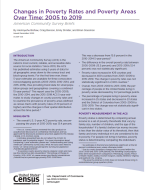Changes in Poverty Rates and Poverty Areas Over Time: 2005 to 2019
Changes in Poverty Rates and Poverty Areas Over Time: 2005 to 2019
Poverty is an important indicator of economic well-being. Policymakers often use poverty rates as a key indicator of current economic conditions within communities and to make comparisons across demographic groups. Poverty rates, measured as the proportion of people in poverty, are often used to identify communities in need and to estimate the number of families eligible for various government programs.
Census tracts with poverty rates greater than or equal to 20 percent are designated as "poverty areas" by the U.S. Census Bureau. Researchers have found that low-income families living in a community with high poverty concentrations face a number of economic and social challenges. In recognition of these challenges, some government programs use poverty areas to determine need.
This brief uses the 2005-2009, 2010-2014, and 2015-2019 American Community Surveys (ACS) 5-year estimates, the first ACS instance of three non-overlapping periods, to analyze poverty rates and poverty areas for the nation, states and counties. The percentage of people living in poverty areas by state and change over time is examined. This brief also reviews county poverty rates and changes over the three non-overlapping time periods.
Others in Series
Publication
Publication
Publication





